#USS South Dakota (BB-57)
Text

Crewmen haul down the National Ensign as USS SOUTH DAKOTA (BB-57) is decommissioned, at the Philadelphia Naval Base, Pennsylvania.
Date: January 31, 1947
U.S. Naval History and Heritage Command: NH 73929
#USS SOUTH DAKOTA (BB-57)#USS SOUTH DAKOTA#South Dakota Class#Battleship#Warship#Ship#United States Navy#U.S. Navy#US Navy#USN#Navy#Philadelphia Navy Yard#Philadelphia#Pennsylvania#East Coast#Delaware River#January#1947#post war#postwar#decommissioning#decommission#my post
19 notes
·
View notes
Photo
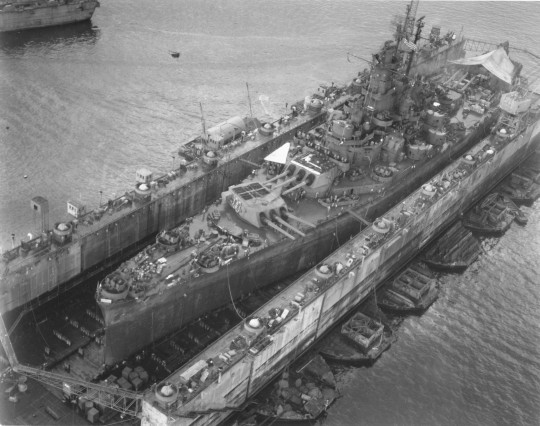
Cuirassé USS South Dakota (BB-57) en réparation dans la cale sèche flottante USS ABSD-6 (Advance Base Sectional Dock-6) – Ile de Guam – 1945
Le 6 mai 1945, le cuirassé South Dakota reçoit des munitions depuis le bateau ravitailleur USS Wrangell (AE-12) sur l'île d'Okinawa. Pendant le chargement une charge de poudre explosa dans le magasin de la tourelle n°2 des canons de 410 mm. Le magasin fut inondé immédiatement pour éviter une explosion générale. 11 marins furent tués et 24 autres furent blessés dans l'accident.
Le cuirassé fut ramené à Guam pour réparations dans une cale sèche flottante, l'USS ABSD-6. Véritable chantier naval autonome, avec 2 grues mobiles sur rails, centrales électriques, pompes de ballast, ateliers de réparation et ateliers d'usinage, l'USS ABSD-6 pouvait recevoir pour réparations porte-avions, cuirassés et croiseurs en leur évitant de retourner à leur port d'attache réduisant ainsi considérablement de plusieurs mois les délais de retour au combat.
#WWII#Guerre du Pacifique#Pacific War#Marine américaine#US Navy#USN#Marine militaire#Military navy#Cuirassé#Battleship#Classe South Dakota#South Dakota class#USS South Dakota (BB-57)#USS South Dakota#BB-57#Réparations#Repairs#Réparation navale#Ship repair#Cale sèche#dry dock#Advance Base Sectional Dock#USS ABSD-6#Ile de Guam#Guam Island#Guam#Etats-Unis#United States of America#USA#1945
3 notes
·
View notes
Text

USS South Dakota (BB-57) in the floating drydock ABSD-3 at Guam.
77 notes
·
View notes
Text

USS South Dakota (BB-57). Operating off the U.S. east coast, 9 August 1943
47 notes
·
View notes
Photo

“The Stage Is Set" As promised: our big post we hinted about yesterday, and it will be in two parts. 80 Years Ago - (Sunday) Nov 15th, 1942: For all the insanity happening in the Atlantic and North Africa, half a world away in the Solomon Islands, the island of Guadalcanal – and the waters around it – have become ground zero. It is the opening stage of the ground offensive to retake the Pacific, and men, supplies, planes, and ships from both sides are being hurled into it. Neither side can afford to lose it, and efforts from the Americans and the Imperial Japanese are exceeding beyond maximum. The day of the Battleship is waning, but that doesn’t mean that several dozen of these steel monsters still patrol the seas with their massive guns. Eclipsed by the aircraft carrier, the battlewagons still have plenty of life – and lethality – left in them. The Naval Battle Of Guadalcanal started on November 12th. I don’t have enough room in a hundred posts to cover it all, other than it is a wild, and horrifically savage fight that involves everything from destroyers to battleships. Both sides have been chewing away at each other for two days with no clear winner. The stage is set for one violent, brutal climax. Steaming in comes US Navy Task Force 54, with 6 ships, under Admiral Willis A. Lee. It comprises the battleships USS Washington (BB-56, North Carolina-Class, Photo 1) and USS South Dakota (BB-57, South Dakota-Class, Pic 2) and an escort of four destroyers: USS Walke, Preston, Benhim, and Gwin, respectively. Heading straight for them in the pitch dark is a Japanese task force under Admiral Nobutake Kondō. It has FOURTEEN ships: the battleship Kirishima (Kongo-Class, Photo 3), 2 heavy and 2 light cruisers and 9 destroyers. At less than 10 miles from one another, the battle opens. In short order, all four American destroyers are sunk or knocked out; Washington knocks out one Japanese destroyer. Things go right out the window when South Dakota suffers a catastrophic electric failure; she loses her radios, radar, and firing capability. Spotlighting her, the Japanese tear into South Dakota rake her with fire. Washington is now on her own. Stand by for Part 2! (at Fort Hancock, New Jersey) https://www.instagram.com/p/ClDBerItt8K/?igshid=NGJjMDIxMWI=
6 notes
·
View notes
Text
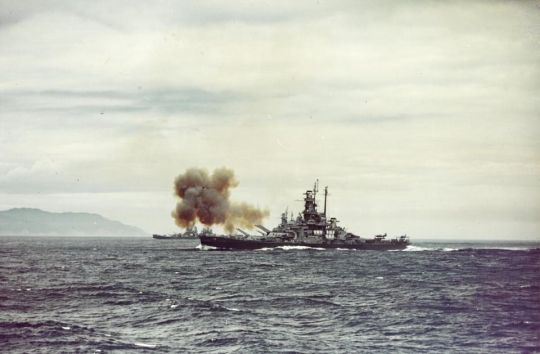
USS Indiana (BB-58) fires a salvo from her forward 16/45 guns at the Kamaishi plant, 250 miles north of Tokyo. Moments before, USS South Dakota (BB-57), from which this photo was taken, fired the first naval gunfire bombardment of the Japanese Home Islands. 14 July 1945.
0 notes
Photo
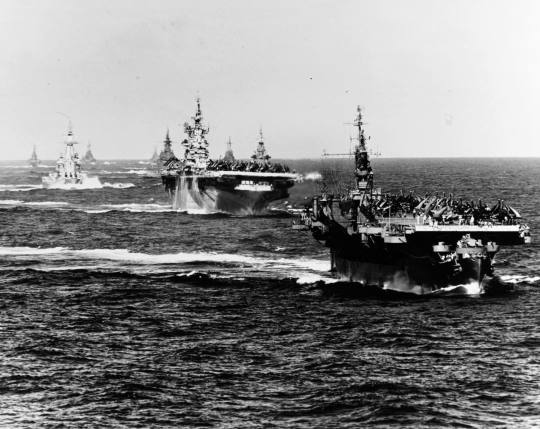
Task Group 38.3 enters Ulithi anchorage after strikes in the Philippines Islands, 12 December 1944. Ships include USS Langley (CVL-27), USS Ticonderoga (CV-14), USS Washington (BB-56), USS North Carolina (BB-55), USS South Dakota (BB-57), USS Santa Fe (CL-60), USS Biloxi (CL-80), USS Mobile (CL-63), and USS Oakland (CL-95).
NA 80-G-301352
0 notes
Photo





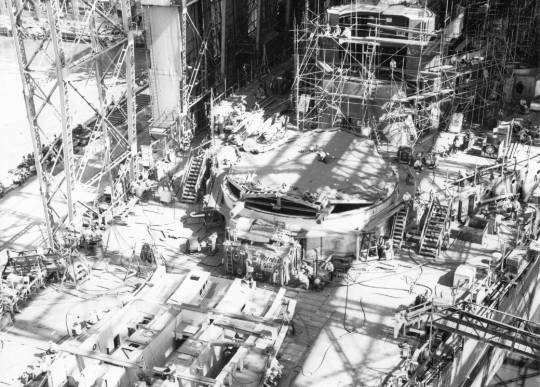


Construction of the South Dakota BB-57
17 notes
·
View notes
Photo
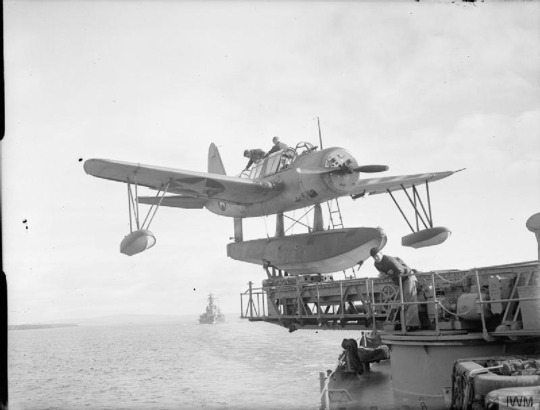
Crewmen climb into an OS2U on the aft catapult of USS South Dakota (BB-57) while attached to the British Home Fleet at Scapa Flow, 1943
76 notes
·
View notes
Photo
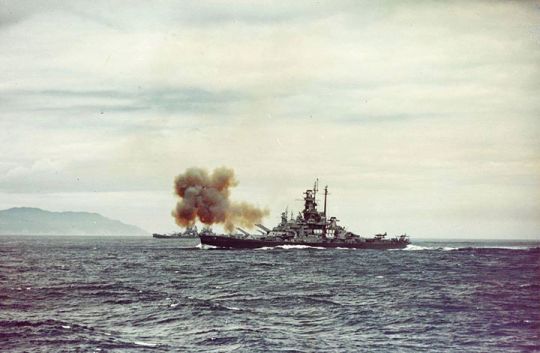
USS Indiana (BB-58) fires a salvo from her forward 16/45 guns at the Kamaishi plant of the Japan Iron Company, 250 miles north of Tokyo. A second before, USS South Dakota (BB-57), from which this photograph was taken, fired the initial salvo of the first naval gunfire bombardment of the Japanese Home Islands. The superstructure of USS Massachusetts (BB-59) is visible directly behind Indiana. The heavy cruiser in the left center distance is either USS Quincy (CA-71) or USS Chicago (CA-136) https://wrhstol.com/2Adc4de
27 notes
·
View notes
Text

"Lead ship of a new class of more compact fast battleships, USS South Dakota (BB-57) had the same speed and gun battery as the North Carolina class, but she had a better armor-protection scheme. She underwent mothballing at Philadelphia in 1946, the fate of nearly all the battleships at war's end. This photo, taken in 1962, shows the mothball period coming to an end as the ship, with less than five years' commissioned service on her record, is towed away to be scrapped."
(Naval Institute Collection)
#USS SOUTH DAKOTA (BB-57)#USS SOUTH DAKOTA#South Dakota Class#Battleship#Warship#Ship#United States Navy#U.S. Navy#US Navy#USN#Navy#November#1962#my post
26 notes
·
View notes
Text

Des avions japonais ciblent le porte-avions USS Enterprise (CV-6) – Bataille des îles Santa cruz – Campagne de Guadalcanal – Campagne des îles Salomon – Guerre du Pacifique – 26 octobre 1942
©Naval History and Heritage Command – 80-G-20989
L'USS Enterprise (CV-6) est à gauche, avec au moins deux avions ennemis visibles au-dessus. A droite le cuirassé USS South Dakota (BB-57) tire une salve de sa batterie tribord comme l'indique le flash lumineux au centre du navire.
#WWII#guerre du pacifique#pacific war#campagne des îles salomon#solomon islands campaign#campagne de guadalcanal#guadalcanal campaign#bataille des îles santa cruz#battle of the santa cruz islands#bataille navale#naval battle#uss enterprise#îles santa cruz#santa cruz islands#26/10/1942#10/1942#1942
12 notes
·
View notes
Text

The USS South Dakota (BB-57) left California on her final Pacific voyage. She transited through the Panama Canal, and arrived at the Philadelphia Naval Shipyard on 20 January for a yard overhaul. In June of the same year she was attached to the Atlantic Reserve Fleet. On 31 January 1947, she was decommissioned and placed in reserve status.
Photo- The SOUTH DAKOTA arrives at the Philadelphia Naval Shipyard on 20 January 1946.
61 notes
·
View notes
Photo
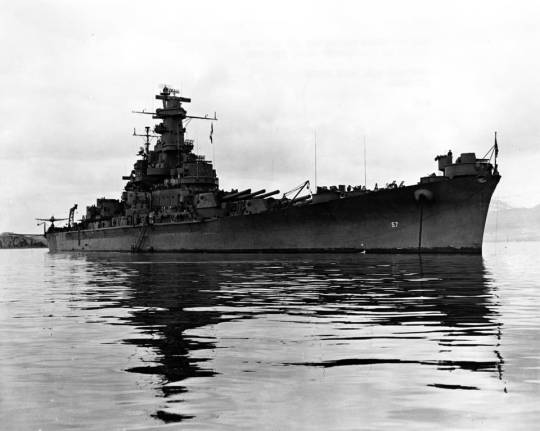
The U.S. Navy battleship USS South Dakota (BB-57) anchored in Hvalfjörður, Iceland, on 24 June 1943
31 notes
·
View notes
Photo

USS Smith (DD-378) refueling from USS South Dakota (BB-57) on 28 October 1942. Her two forward 5"/38 guns and much of her forward superstructure are burned out and otherwise damaged, the result of a Japanese torpedo plane that crashed into her two days earlier, during the Battle of the Santa Cruz Islands.
(Source)
124 notes
·
View notes
